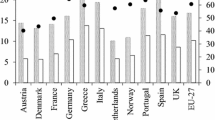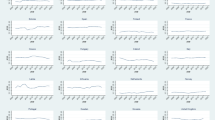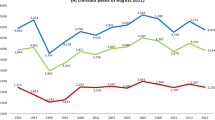Abstract
This paper addresses a key methodological challenge in the modeling of individual poverty dynamics—the influence of measurement error. Taking the US and Britain as case studies and building on recent research that uses latent Markov models to reduce bias, we examine how measurement error can affect a range of important poverty estimates. Our data are taken from the British Household Panel Survey and the US Panel Study of Income Dynamics, for working-aged adults over the period 1993–2003. For both national samples we ask how common vulnerability to poverty was over the period in question, what the entry and exit probabilities were for the group likely to transition into or out of poverty, and how effective redistributive programs were at protecting those most at risk. Crucially, in answering these questions we estimate and remove the effects of error in the measurement of poverty status. Throughout, we compare our results with estimates that do not take this error into account, and assess the implications for understanding poverty dynamics both within and between the two countries. Our modeling strategy extends previous research in several respects, enabling us to make stronger statements about measurement error and individual poverty dynamics. We find that correcting for error affects conclusions in important ways: Poverty is less temporary and risks are less widely dispersed than otherwise assumed, while cross-national differences are more pronounced.

Similar content being viewed by others
Notes
Household heads are defined as the husband in couple households, and the male or female adult in single-adult households.
For the PSID, information on total taxes and deductions was not collected from the 1992 wave onward. The CNEF variable used in our analyses estimates federal and state income taxes using the National Bureau of Economic Research TAXSIM model (Butrica and Burkhauser 1997; Feenberg and Coutts 1993), applied to existing income data. For the BHPS, disposable incomes were calculated from net income figures by analysts at the Institute for Social and Economic Research, where the survey originates, and included in the original dataset (see Bardasi et al. 1999).
We note that the construction of the CNEF self-rated health variable assumes equivalence across the two surveys, for the waves in our analyses.
The very few cases in the ‘don’t know’ category for each national sample were coded missing.
We categorize age to allow the functional form of the relationship between age and poverty to be non-parametric.
Additional model output is available on request.
References
Alwin, D. (2007). Margins of error: A study of reliability in survey measurement. Hoboken, NJ: Wiley-Interscience.
Andersen, R., Kaspar, J., & Frankel, M. R. (1979). Total survey error: Applications to improve health surveys. San Franciso: Jossey-Bass Publishers.
Bane, M. J., & Ellwood, D. (1986). Slipping into and out of poverty: The dynamics of spells. Journal of Human Resources, 21(1), 1–23.
Bardasi, E., Jenkins, S. P., & Rigg, J. A. (1999). Documentation for derived current and annual net household income variables, waves 1–7. University of Essex, Colchester, England: Institute for Social and Economic Research Working Paper 99-25.
Bassi, F., Hagenaars, J. A., Croon, M. A., & Vermunt, J. K. (2000). Estimating true changes when categorical panel data are affected by uncorrelated and correlated classification errors. Sociological Methods & Research, 29, 230–268.
Blalock, H. M. (1969). Multiple indicators and the causal approach to measurement error. American Journal of Sociology, 75, 264–272.
Breen, R., & Moisio, P. (2004). Poverty dynamics corrected for measurement error. Journal of Economic Inequality, 2, 171–191.
Butrica, B. A., & Burkhauser, R. (1997). Estimating federal income tax burdens for panel study of income dynamics (PSID) familiesusing the national bureau of economic research TAXSIM model. Syracuse, NY: Center for Policy Research, Syracuse University.
Collins, L. M., Schafer, J. L., & Kam, C. M. (2001). A comparison of inclusive and restrictive strategies in modern missing data procedures. Psychological Methods, 6, 330–351.
Costner, H. L. (1969). Theory, deduction and rules of correspondence. American Journal of Sociology, 75, 245–263.
Duncan, G. J. (1984). Years of poverty, years of plenty. Ann Arbor, MI: Institute for Social Research.
Duncan, G., Gustafsson, B., Hauser, R., Schmauss, G., Messinger, H., Muffels, R., et al. (1993). Poverty dynamics in eight countries. Journal of Population Economics, 6, 215–234.
Enders, C. K. (2001). The performance of the full information maximum likelihood estimator in multiple regression models with missing data. Educational and Psychological Measurement, 61, 713–740.
Feenberg, D., & Coutts, E. (1993). An introduction to the TAXSIM model. Journal of Policy Analysis and Management, 12(1), 189–194.
Forster, M. F. (2001). When money is tight: Poverty dynamics in OECD countries. Paris: Organisation for Economic Co-operation and Development.
Forster, M., & d’Ercole, M. M. (2005). Income distribution and poverty in OECD countries in the second half of the 1990s. Paris: OECD.
Fouarge, D., & Layte, R. (2005). Welfare regimes and poverty dynamics: The duration and recurrence of poverty spells in Europe. Journal of Social Policy, 34(3), 407–426.
Groves, R. M. (1991). Measurement error across the disciplines. In P. Biemer, R. M. Groves, L. E. Lyberg, N. A. Mathiowetz, & S. Sudman (Eds.), Measurement error in surveys (pp. 1–25). New York: John Wiley & Sons.
Heise, D. R. (1969). Separating reliability and stability in test–retest correlation. American Sociological Review, 34, 93–101.
Hill, M. (1992). The panel study of income dynamics: A user’s guide. Newbury Park, CA: Sage.
Jarvis, S., & Jenkins, S. P. (1999). Marital splits and income changes: Evidence from the British household panel survey. Population Studies, 53(2), 237–254.
Jenkins, S. P. (2000). Modelling household income dynamics. Journal of Population Economics, 13, 529–567.
Jenkins, S. P., & Rigg, J. A. (2001). The dynamics of poverty in Britain. London: Department for Work and Pensions.
Kaplan, D. (2008). An overview of Markov chain methods for the study of stage-sequential developmental processes. Developmental Psychology, 44, 457–467.
Langeheine, R., & van de Pol, F. (1990). A unifying framework for Markov modeling in discrete space and discrete time. Sociological Methods and Research, 18, 416–441.
Leisering, L., & Leibfried, S. (1999). Time and poverty in western welfare states. New York, NY: Cambridge University Press.
Lessler, J. T., & Kalsbeek, W. D. (1992). Nonsampling error in surveys. New York, NY: Wiley.
Little, T. D., & Rubin, D. B. (1987). Statistical analysis with missing data. York, NY: John Wiley and Sons.
McKernan, S., & Ratcliffe, C. (2005). Events that trigger poverty entries and exits. Social Science Quarterly, 86, 1146–1169.
Mirowsky, J., & Kim, J. (2007). Graphing age trajectories: Vector graphs, synthetic and virtual cohort projections, and virtual cohort projections, and cross-sectional profiles of depression. Sociological Methods & Research, 35, 497–541.
Moisio, P. (2004). Poverty dynamics according to direct, indirect, and subjective measures. Helsinki: National Research and Development Centre for Welfare and Health.
Moller, S., Bradley, D., Huber, E., Nielsen, F., & Stephens, J. D. (2003). Determinants of relative poverty in advanced capitalist democracies. American Sociological Review, 68(1), 22–51.
Muthén, L. K., & Muthén, B. O. (2006). Mplus statistical analysis with latent variables: User’s guide (4th ed.). Los Angeles, CA: Muthén and Muthén.
Nylund, K. L., Muthén, B., Nishina, A., Bellmore, A., & Graham, S. (2006). Stability and instability of peer victimization during middle school: Using latent transition analysis with covariates, distal outcomes, and modeling extensions. Retrieved May 31, 2007 from http://www.statmodel.com/papers.shtml.
O’Connor, A. (2000). Poverty research and policy for the post-welfare era. Annual Review of Sociology, 26, 547–562.
Office for National Statistics. (2005). The national statistics socio–economic classification user manual. Basingstoke: Palgrave Macmillan.
Rank, M. R., & Hirschl, T. A. (2001). The occurrence of poverty across the life cycle: Evidenced from the PSID. Journal of Policy Analysis, 20(4), 737–755.
Rendtel, U., Langeheine, R., & Berntsen, R. (1998). The estimation of poverty dynamics using different measurements of household income. Review of Income and Wealth, 44, 81–98.
Rendtel, U., Nordberg, L., Jantti, M., Hanisch, J., & Basic, E. (2004). Report on quality of income data. CHINTEX Working Paper #21, Federal Statistical Office, Germany.
Rigg, J., & Sefton, T. (2006). Income dynamics and the life cycle. Journal of Social Policy, 35(3), 411–435.
Schwarz, G. (1978). Estimation of the dimension of a model. Annals of Statistics, 6, 461–464.
Taylor, M., Brice, J., Buck, N., & Prentice-Lane, E. (2003). British household panel survey user manual volume a: Introduction, technical report and appendices. Colchester: University of Essex.
US Department of Commerce, Bureau of the Census. (1971). 1970 census of population classified index of industries and occupations. Washington, DC: US Government Printing Office.
Valletta, R. G. (2006). The ins and outs of poverty in advanced economies: Government policy and poverty dynamics in Canada, Germany, Great Britain, and the United States. Review of Income and Wealth, 52(2), 261–284.
Van de Pol, F., & de Leeuw, J. (1986). A latent Markov model to correct for measurement error. Sociological Methods & Research, 15, 118–141.
Walker, R., & Wiseman, M. (2003). The welfare we want? The British challenge for American reform. Bristol, UK: The Policy Press.
Whelan, C. T., Layte, R., & Maitre, B. (2003). Persistent income poverty and deprivation in the European Union: An analysis of the first three waves of the European community household panel. Journal of Social Policy, 32(1), 1–18.
Whelan, C. T., & Maitre, B. (2006). Comparing poverty and deprivation dynamics: Issues of reliability and validity. Journal of Economic Inequality, 4, 303–323.
Wiggins, R. D., & Sacker, A. (2002). A comparative evaluation of strategies to handle missing data in the context of structural equation modelling: A user’s perspective. In G. Marcoulides & I. Moustaki (Eds.), Latent variable latent structure models (pp. 105–120). Mahwah, NJ: Lawrence Erlbaum Associates.
Wothke, W. (2000). Longitudinal and multigroup modeling with missing data. In T. D. Little, K. U. Schnabel, & J. Baumert (Eds.), Modeling longitudinal multilevel data: Practical issues, applied approaches, specific examples (pp. 219–240). Mahwah, NJ: Lawrence Erlbaum.
Yamaguchi, K. (2008). Four useful finite mixture models for regression analyses of panel data with a categorical dependent variable. Sociological Methodology, 38(1), 283–328.
Acknowledgments
The research for this paper was supported by funding from the Canadian Institutes for Health Research (grant #PPR 79227) and the Social Sciences and Humanities Research Council of Canada (grant #410-07-0913). Amanda Sacker was supported, in part, by an ESRC International Centre for Life Course Studies in Society and Health grant RES-596-28-0001 and an ESRC Research Centre on Micro-Social Change grant RES-518-28-5001.
Author information
Authors and Affiliations
Corresponding author
Appendix
Rights and permissions
About this article
Cite this article
Worts, D., Sacker, A. & McDonough, P. Re-Assessing Poverty Dynamics and State Protections in Britain and the US: The Role of Measurement Error. Soc Indic Res 97, 419–438 (2010). https://doi.org/10.1007/s11205-009-9509-7
Received:
Accepted:
Published:
Issue Date:
DOI: https://doi.org/10.1007/s11205-009-9509-7




